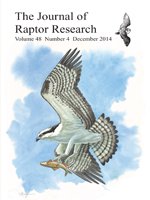From 2005–2008 we used counts of visible migrants at an inland watchsite (La Gran Piedra) 9 km from the coast and a coastal watchsite (Siboney) to describe the magnitude and timing of Osprey (Pandion haliaetus) autumn migration through southeastern Cuba from 1 August through 30 November. Counts of Ospreys at Siboney averaged 5283 (2006–2008) annually or roughly twice those tallied at other North American watchsites known for the concentration of this species during autumn migration. Nevertheless, simultaneous counts at both watchsites better represent the magnitude of its migration through southeastern Cuba, averaging more than 7000 Ospreys (3 yr). The mean seasonal passage window (95% of the flight) ranged from 78 to 83 d at La Gran Piedra and Siboney. The average peak at both sites occurred in early October, with more than 20 Ospreys/hr. The daily passage window (95% of the daily passage) was more protracted at Siboney, where birds migrated both early in the morning and late in the afternoon, than at the inland mountain site at La Gran Piedra, where Osprey numbers peaked at midday. We believe that Ospreys migrating in southeastern Cuba move from the coast to the mountains at midday in response to thermal convections along the mountains at that time. Osprey flocks observed at watchsites ranged between 2–52 individuals and one flock of 92 individuals was observed at a dam in central Cuba.
Durante el periodo 2005–2008 utilizamos conteos de migrantes en un sitio de observación tierra adentro (La Gran Piedra) a nueve kilómetros de la costa y en un sitio de observación costero (Siboney) para describir la magnitud y ritmo de la migración otoñal de Pandion haliaetus a lo largo del sureste de Cuba desde el primero de agosto hasta el 30 de noviembre. Los conteos de P. haliaetus en Siboney promediaron 5283 individuos (2006–2008) anualmente, o aproximadamente el doble de los conteos de otros sitios de observación norteamericanos conocidos por la concentración de esta especie durante la migración otoñal. Sin embargo, conteos simultáneos en ambos sitios representan mejor la magnitud de la migración de P. haliaetus en el sureste de Cuba, promediando más de 7000 individuos (3 años). El paso promedio estacional (95% del total) fluctuó de 78 a 83 días en La Gran Piedra y Siboney. El pico promedio en ambos sitios ocurrió a principios de octubre con más de 20 águilas/hr. El paso diario (95% del paso diario) se prolongó más en Siboney, donde las águilas volaron preferentemente temprano en la mañana y a última hora en la tarde, que en el sitio montañoso en La Gran Piedra donde volaron preferentemente al mediodía. Sugerimos que los individuos migrantes de P. haliaetus en el sureste de Cuba se mueven desde la costa hacia las montañas al mediodía en respuesta a la concentración de corrientes termales en las cadenas montañosas a esta hora del día. Las bandadas de P. haliaetus observadas en los sitios de observación fluctuaron entre 2 y 52 individuos y se observó una bandada de 92 individuos en una presa en el centro de Cuba.





